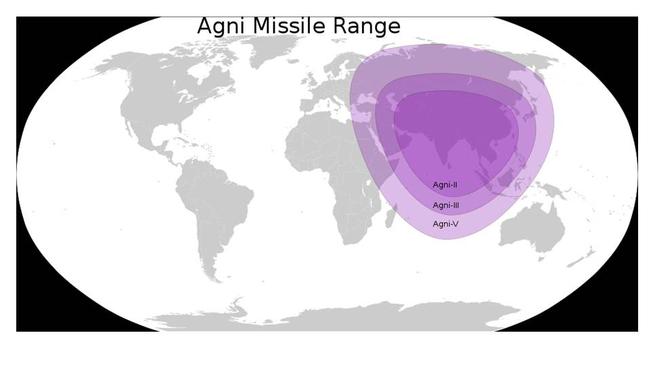The successful launch of the Intercontinental Ballistic Missile (ICBM), Agni-V, has not only catapulted India into the elite group of nations possessing ICBM’s, but also conveyed a bold foreign policy statement.
Vijay Kumar Saraswat, chief of the Defence Research and Development Organization (DRDO) which designed and manufactured the strategic missile, was quick to announce that the missile was “not any country specific”. Despite this, the political message emanating from the launch has not been lost on anybody. The strategic missile is proposed to be inducted in the Indian army within a couple of years, after two more experimental launches. Regional Relationships or the ‘Game’ For the missile’s ability to carry nuclear warheads and its strike range of 5500-5800 kilometers, Saraswat referred to it as a “game changer”. The traditionally coy Indian foreign policy would never overtly aver to the ‘game’. It began in 1950 between the Asian neighbors India and China when China annexed Tibet. Indian foreign policy, warped as it was by Prime Minister Jawahar Lal Nehru’s obsession with ‘non alignment’, failed to foresee Tibet’s importance as a geo-strategic buffer. Ironically, Nehru continued to promote the Chinese membership to the United Nations. Like a true imperialist, China then advanced claims towards Indian territory. The disputed area of Aksai Chin in India was the apparent reason for the Chinese invasion in 1962. Nehru exemplified Indian ambivalence with his “not an inch of grass grows there” statement regarding the areas under Chinese invasion. The politically and militarily unprepared Indians did not stand a chance. The distrust between the two Asian giants has continued to grow ever since. Through judicious economic reforms and infrastructure building, the Chinese dragon has charged ahead of the lumbering Indian elephant. The Indian polity on the other hand, mired in indecision and corruption, has been dragging down economic reforms. Aware of the historical truth of military strength augmenting economic growth, the Chinese have steadily built up their conventional and nuclear arsenal. The annual Indian defence budget of US$ 41bn pales in comparison to the Chinese defence budget of US$ 106.4bn. India is hemmed in by the nuclear armed and hostile neighbors China on one side and Pakistan, with which India has fought five conventional wars, on the other side. Despite this, India had failed to articulate a realistic foreign policy protecting its self-interest. Realpolitik has never found favor with the Indian political establishment. Territory disputes India and China have a longstanding border dispute which even after decades of negotiations and innumerable confidence building measures (CBM) remains unresolved. Chinese claims over the Indian state of Arunachal Pradesh and the intemperate foreign policy statements issued periodically from Beijing have kept the pot boiling. The Chinese government still refers to the state as “disputed territory”. In 2009, China protested Indian Prime Minister Manmohan Singh’s visit to the state. This was met with an immediate riposte from India, with the foreign minister asserting Arunachal to be “an integral part of India”. The Chinese have also strategically utilized the traditional hostility between India and Pakistan in order to keep up the heat on India’s western frontiers. The ploy has served the Chinese remarkably well with Indian public and political opinion focused on Pakistan, countenancing the Chinese threat. The Chinese tilt towards the Pakistani position on the disputed state of Kashmir is a manifestation of the Chinese policy of keeping India busy in containing Pakistan. That China has become a major supplier of Pakistani defence equipments has not escaped the eyes in New Delhi. But it was the arrest of Abdul Qadeer Khan, the pioneer of the Pakistani nuclear establishment, for nuclear proliferation activities that raised Indian concerns over the nexus between China and Pakistan. Khan was the kingpin of an international proliferation racket illicitly trading Pakistani nuclear technology for North Korean strategic missiles. Pakistan flaunts these as indigenous strategic missiles and deterrents against perceived Indian ‘designs’ on Pakistan. Provocatively enough, these ‘Pakistani’ missiles are named after Muslim plunderers who had invaded India during the Middle Ages. North Korea has a non-existent indigenous missile programme and it is dependent on the Chinese for technological and financial assistance. Leon Panetta, the US Defence Secretary informed the United States House Committee on Armed Services: “I'm sure there's been some help coming from China. I don't know […] the exact extent of that." These missiles ended up in Pakistan through the support of the clandestine Khan network. This again exemplified the Chinese and Pakistani collusion. The veiled intimidation of the Chinese government in order to expand its hegemony has continued to rankle the Indian policy makers. China’s Apprehensions China views with suspicion the presence of the Dalai Lama and the Tibetan government-in-exile based in India. Although China has arm twisted the Indian government into restricting the Dalai Lama’s freedom of expression and political activities in India, it remains wary of Indian intentions. Recent events in the South China Sea have again raised apprehensions in New Delhi. The Chinese had objected to Indian oil exploration in resource rich Vietnamese blocks, referring to the area as ‘disputed’ and asking India to ensure “peace and stability”. Reasons for Agni-V India went nuclear in 1998 and has an established ‘no first use’ nuclear policy. Therefore a credible nuclear deterrent became an imperative for the Indian defence forces. The earlier versions of the Agni missile provided India the tool to negate the Pakistani missile threat. Bereft of a missile system capable of threatening strategic cities in China, the Indians felt vulnerable. The Chinese superiority in numbers and technology compelled India to seek a nuclear deterrent to achieve parity. In a throwback to the Cold War era and the mutual assured destruction (MAD) doctrine, the Agni-V missile has provided the Indians the desperately required nuclear deterrent. The Chinese response has been predictable. The official spokesperson of the Chinese foreign ministry declared that the two countries were “not competitors but partners”. But as is their wont, the Chinese establishment utilized the tightly controlled media to express their opinion. The Global Times, believed to be close to the hardliners in the army and the party, pejoratively declared that “India should not overestimate its strength”. The tabloid subtly reminded the Indians of the humiliation in the 1962 conflict, writing that India “would not profit from being arrogant during disputes with China”. The Chinese media has also advised India against falling into the trap of ‘vested interests’ and ‘falling prey to the arms race.’ India needs to steer clear of the polemics and articulate policies serving its national interests. The 1962 debacle with China showed that peaceful intentions without the backing of military strength have always been considered as a sign of weakness and invariably exploited. Agni-V has provided India a credible strategic deterrent to counter muscle flexing by China in active collusion with Pakistan. The ‘game’ might not change, but the realpolitik of Agni-V has the potential to balance it. The views expressed in this article are the author's own and do not necessarily reflect Fair Observer’s editorial policy.
Support Fair Observer
We rely on your support for our independence, diversity and quality.
For more than 10 years, Fair Observer has been free, fair and independent. No billionaire owns us, no advertisers control us. We are a reader-supported nonprofit. Unlike many other publications, we keep our content free for readers regardless of where they live or whether they can afford to pay. We have no paywalls and no ads.
In the post-truth era of fake news, echo chambers and filter bubbles, we publish a plurality of perspectives from around the world. Anyone can publish with us, but everyone goes through a rigorous editorial process. So, you get fact-checked, well-reasoned content instead of noise.
We publish 2,500+ voices from 90+ countries. We also conduct education and training programs
on subjects ranging from digital media and journalism to writing and critical thinking. This
doesn’t come cheap. Servers, editors, trainers and web developers cost
money.
Please consider supporting us on a regular basis as a recurring donor or a
sustaining member.
Will you support FO’s journalism?
We rely on your support for our independence, diversity and quality.







Comment